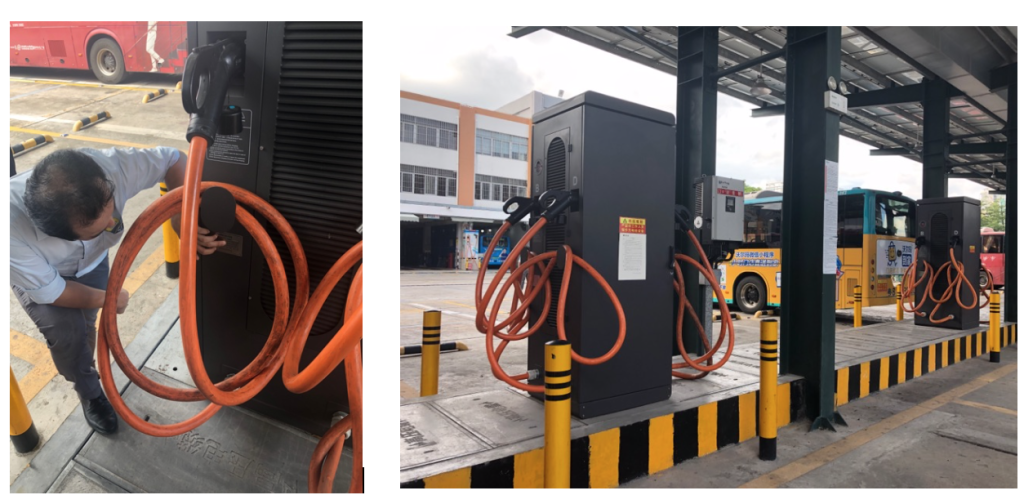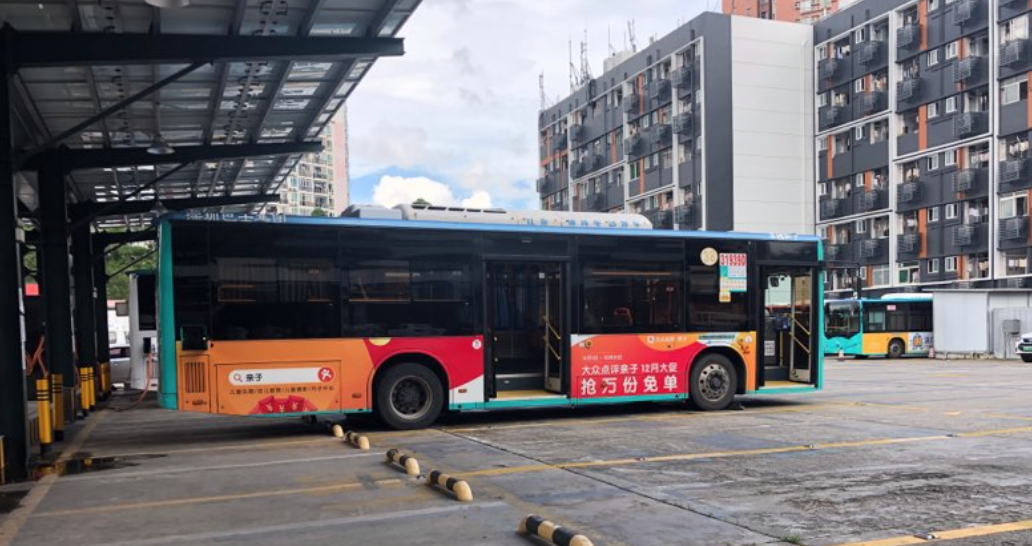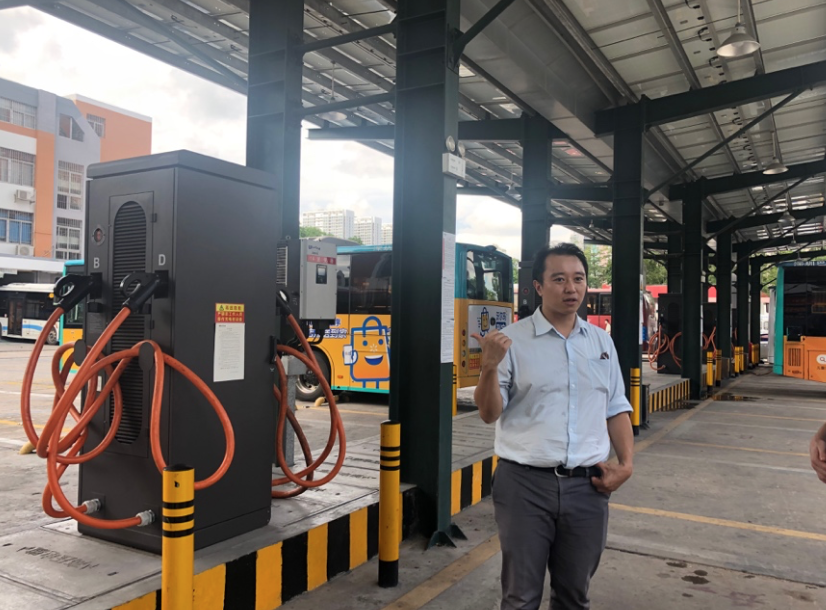The First and Largest 100 Percent Electric Bus Fleet: Shenzhen Bus Group
June 11, 2019
Pictured above are the charging piles which electrify the buses. These are located at the depots.
On June 5, we visited a depot of Shenzhen Bus Group (SZBG), as well as their headquarters. At the depot, we were given an initial introduction to the company and its operations. Here, we were also shown the charging piles and how to insert them into the buses.
By one of the buses, we were transported to the headquarters where we had a more in-depth discussion through Q and A. We met with Hallie Lou and Chris Liang. Shenzhen Bus Group was established in 2005 as a branch of KMB Transport International. The company is recognized globally as the first and largest 100% electric bus fleet. The company’s mission statement shares their vision:
“Our vision to be a global leader in public transport is based on three principles: understanding the needs of the people we serve, introducing innovative technologies that further environmental preservation, and achieving new standards for safety, service and efficiency.”
Shenzhen’s history has deep ties to public transport, since their comprehensive bus system began operation in 1975, as the city itself was beginning to develop. The city has grown to an official population of 12 million individuals, and an unofficial population of 23 million. With so many people, it is very important that they can be moved around safely and efficiently. Their metro system, taxis, and in this case, buses, make that possible. SZBG now has 6,000 fully-electric buses, and 5,000 electric taxis. Shenzhen as a whole has 16,000 electric buses and goals to convert all remaining taxis to electric. There are many benefits to electrification of public transport, including: reduced noise pollution, reduced air pollution, and encouragement for other cities to make the same switch.

SZBG is a company in the public sector, which means their focus is not on making profit, but more on the needs of the people. This exemplifies the first principle of SZBG’s mission statement, ‘understanding the needs of the people we serve.’ During the visit, company officials shared a variety of ways that this is achieved. SZBG employs many strategies to keep the people’s best interests in mind. For example, the company has many different bus routes that travel to all parts of Shenzhen, even the more rural and suburban areas. Another strategy this company employs is a voting system which allows riders to vote for new routes. On an app, people will request routes they think should be added and then riders are given the chance to vote for the ones which would benefit them the most. During a trial period, the company monitors ridership to determine if that route should remain in the city. In addition, the company has also introduced an on demand bus service which takes individuals to their specific locations. The fare for this service is only slightly greater than the typical flat bus rate. In our research the manager of SZBG, Joseph Ma stated that “The government looks at the public transport very much as social welfare.” During the visit we were reassured of the importance and accessibility of public transport to meet the needs of all citizens.
SZBG’s second principle in their mission statement is to introduce innovative technologies that further environmental preservation. Their fully electric buses are an obvious example that speaks to this principle. But the company has also furthered their introduction of innovative technologies in other capacities. SZBG has built solar panels at each depot which help electrify some of the buses. However, this use of renewable energy has its advantages and disadvantages. We were told that the solar panels at each depot can only charge four buses at one time. Most depots house around 90-100 buses, charging 24 at a time with their electric piles. The company is not able to charge all buses with solar power, but still prides itself in the fraction of renewable energy they can produce. SZBG has also started researching how to store energy through batteries in the ground. This means for the time buses are not charging, the energy can be stored for later use. This is especially important since buses are charged at night, when the sun is not out. If they wanted to use energy from their solar panels during peak charging times, they would have to utilize innovative energy storage solutions. SZBG charges their buses at night for important reasons. It saves them money because electricity prices are lower at night. During this visit, we were given this figure: for every 1 minute more charging at night over during the day, SZBG saves about 500 RMB. An idea discussed on the visit was the repurposing of used bus batteries. The company shared that the life cycle of both buses and batteries is around 7-8 years. SZBG is beginning to replace its first batch of electric buses, so this repurposing would occur in the near future. The benefits that come with energy storage would allow for a greater percentage of renewable energy to be used by SZBG. It also would maintain the lower costs of charging at night, since solar energy could be stored and used later.
The third sector of SZBG’s mission statement is to achieve new standards for safety, service, and efficiency. Being the first fully electric bus fleet, the company has proven itself as capable of achieving these new goals. A huge focus of the visit was on how these new technologies and services are implemented. We learned in our visit about the subsidies both the central and local governments provide to SZBG. More than half of the bus’s price is subsidized by the government, and subsidies are put in place for their usage as well. Operational subsidies can reduce bus fares, increasing accessibility to the public. It is important to note also, that these buses are initially much more expensive than diesel buses. This is why any company wanting to start this kind of company needs a very large sum of money. The Chinese government provided these assets due to their realization that over the lifecycle of the electric bus, they are much less costly to maintain and operate compared to a diesel bus. This company would never be capable of electrifying all of Shenzhen’s buses and taxis without assistance and support from the government. A leader in SZBG shared that the United States has 300 electric buses, while China has 421,000. This contrast is so huge due to the important role that government plays in Chinese innovation. Bipartisanship and discounting the future in America creates a society that is slow to innovation. For example, in RDU the light rail project was discussed for years before eventually being dismissed due to a perceived lack of initial ridership. SZBG shared that the ridership on their electric buses is rather low, and the metro is used much more by the public. Rather than competing with the metro system, SZBG has goals to work alongside other modes of transit, showing their dedication to being a public service, rather than a private entity. Despite low ridership, the government still funds innovation efforts for buses in Shenzhen – something Durham officials refused to do. A huge takeaway from this company visit was the difference in American and Chinese ways of thinking. The government in China recognizes the importance of reducing emissions and making efforts to be more sustainable. The United States, however, is slow to embrace change and accept the reality that renewable energy and the electrification of transportation are the future. This trip highlighted the differences in priorities between countries.
As well as their bus operation and services, SZBG also utilizes an intelligent dispatching system for widespread used cloud computing, big data, internet, and mobile to both improve the human services and enterprise services. In each bus, there are seven cameras that are used for safety, surveillance, etc. These cameras are live streamed to the SZBG control center so SZBG can warn of any road interruptions or other safety concerns beforehand. SIM cards on each bus allow for this to happen as they provide wireless transfer of data. This SIM card can transfer information concerning the charge of the vehicle to the km/day of each bus. All of this data is compiled in one location in a system easy to use. These data and dispatching services aimed to fulfill the riders’ needs. Security measure and data collection also continues to ensure safety, service, and efficiency, as outlined in the mission statement. To conclude, it is important for people to know the story of Shenzhen Bus Group because it exemplifies from start to finish how the company and government are taking actions to serve the people and the environment. SZBG is just one example of how Chinese and American governments have different priorities and ways of thinking, influencing innovation and policy in these nations.

About the Author
Summer Lanier and Sascha Medina
